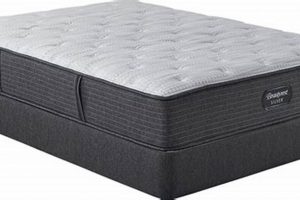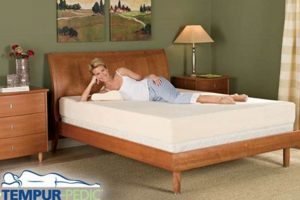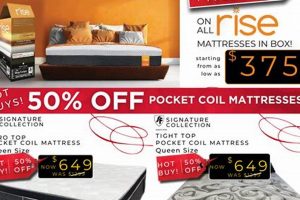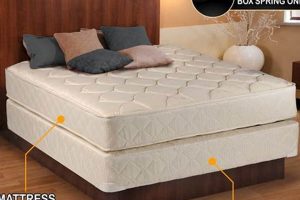These events represent a distinct retail approach focusing on high-volume mattress liquidation. They often occur in temporary locations like warehouses or large event spaces, and are characterized by discounted pricing on a wide selection of mattresses. For example, a manufacturer might host one to clear out overstocked inventory from previous seasons.
The significance of these events lies in their potential for considerable cost savings for consumers. Historically, they have provided an avenue to access quality sleep products at prices significantly below traditional retail markups. This benefits both the customer, who acquires a necessary household item more affordably, and the business, which can efficiently manage inventory and optimize cash flow.
The following will examine the dynamics of these sales, including considerations for navigating them, understanding pricing strategies, and ensuring a satisfactory purchasing experience.
Attending a mattress warehouse event can offer significant savings; however, due diligence is crucial to ensure a satisfactory purchase. The following provides guidance for navigating these sales events.
Tip 1: Research Available Brands and Models Beforehand: Familiarize yourself with mattress brands and constructions to better assess the value offered at the event. A pre-existing understanding will assist in discerning genuine discounts.
Tip 2: Inspect Mattresses Thoroughly: Carefully examine each mattress for any defects, stains, or structural issues. Warehouse settings may not always provide the pristine conditions of a traditional showroom.
Tip 3: Inquire About Warranty and Return Policies: Clarify the warranty terms and return policies applicable to mattresses purchased at the event. These policies may differ from those offered in traditional retail settings.
Tip 4: Negotiate Prices: Engage in price negotiation, particularly if multiple mattresses are being considered or if minor imperfections are identified. Event staff may have the authority to adjust prices to facilitate sales.
Tip 5: Confirm Delivery Options and Associated Costs: Ascertain the availability of delivery services and associated fees. Some events may require purchasers to arrange their own transportation.
Tip 6: Consider the Firmness and Support Levels: Assess the firmness and support levels of mattresses on display. Body alignment is crucial for sleep quality, and mattresses must be suitable for the intended users needs.
Tip 7: Read Online Reviews: Before purchasing, search online reviews of the mattress being considered to get an overview of real world customer experience.
By adhering to these guidelines, one can significantly increase the likelihood of securing a suitable mattress at a competitive price while mitigating potential risks associated with warehouse events.
The conclusion will consolidate these tips into a final recommendation for successful mattress procurement.
1. Inventory Liquidation
Inventory liquidation is a foundational element of mattress warehouse sales. These events serve primarily as channels for businesses to convert excess stock into revenue, often at reduced prices.
- Reduction of Storage Costs
Warehousing mattresses incurs significant costs, including rent, utilities, and personnel. Inventory liquidation through sales events minimizes these expenses by rapidly decreasing the volume of stored goods.
- Capital Recovery
Liquidating inventory recovers capital tied up in unsold mattresses. This infusion of capital can then be reinvested in newer models, marketing efforts, or other business operations.
- Model Transition
As mattress manufacturers introduce new models and technologies, older inventory becomes obsolete. Liquidation events efficiently clear out these outdated mattresses, making room for the latest product lines.
- Mitigation of Depreciation
Mattresses, like many consumer goods, depreciate over time due to wear and tear, storage conditions, and shifting consumer preferences. Liquidation sales accelerate the sale of mattresses before their value diminishes further.
Therefore, inventory liquidation is not merely a clearance tactic; it is a strategic imperative for maintaining financial health and operational efficiency within the mattress industry. Warehouse sales provide a focused and accelerated means of achieving this objective.
2. Temporary locations
The temporary nature of locations is a defining characteristic of mattress warehouse events. These sales rarely occur in established retail spaces. Instead, organizers secure short-term leases on vacant warehouses, convention centers, or similar large-volume spaces. This transience is not arbitrary; it directly impacts both operational costs and consumer perception. Lower overhead due to short-term rental agreements translates to potential cost savings, a portion of which can be passed on to consumers in the form of discounted prices. The urgency implied by a limited-time event in a temporary setting further drives consumer purchasing decisions. One can see examples of this retail model used across the United States, particularly in areas with high rates of consumer spending such as California, Texas and Florida.
The selection of a temporary location also influences the logistical considerations of the event. Organizers must rapidly establish a functional sales environment, including product display, point-of-sale systems, and customer service areas. Conversely, the lack of permanence allows for greater geographic flexibility. Events can be strategically positioned in areas with high consumer traffic or proximity to target demographics. The temporary nature allows for the liquidation process to be expedited and efficiently completed while generating the lowest cost possible.
In conclusion, the temporality of the location is not merely an operational detail; it is a core element of the mattress warehouse sales model. It impacts pricing strategies, consumer psychology, logistical considerations, and overall event effectiveness. Understanding this connection is crucial for both organizers seeking to maximize profitability and consumers aiming to make informed purchasing decisions.
3. Discounted Pricing
Discounted pricing is a central tenet of mattress warehouse sales, distinguishing these events from traditional retail models and acting as a primary driver of consumer interest and purchase behavior.
- Volume Purchasing and Economies of Scale
Warehouse sales often involve the liquidation of substantial mattress quantities. This bulk acquisition allows retailers to negotiate lower per-unit costs from manufacturers, enabling them to offer discounts to consumers. The principle of economies of scale thus directly translates into reduced prices for shoppers.
- Reduced Overhead Costs
Operating from temporary warehouse locations minimizes overhead expenses compared to maintaining permanent retail stores. Lower rent, reduced staffing, and minimal advertising expenditures contribute to a lower cost structure, which is then reflected in the form of discounted mattress prices.
- Inventory Clearance Imperative
A primary motivation behind warehouse sales is the urgent need to clear out existing mattress inventory, whether due to overstocking, model obsolescence, or manufacturer closeouts. To expedite this clearance process, retailers implement aggressive pricing strategies, offering significant discounts to stimulate rapid sales and free up warehouse space.
- Limited Service and Support
Warehouse sales typically provide a more streamlined, self-service shopping experience compared to traditional mattress retailers. The reduction in personalized service, delivery options, and post-sale support contributes to lower operational costs, which are partially passed on to consumers through discounted prices.
These four factors collectively underscore the fundamental role of discounted pricing in mattress warehouse sales. The combination of volume purchasing, reduced overhead, inventory clearance, and limited service allows these events to offer mattresses at prices significantly below those found in conventional retail environments, making them an attractive option for cost-conscious consumers.
4. Brand Variety
Brand variety in mattress warehouse sales is a significant attribute, shaping consumer choices and influencing the competitive landscape of such events. This range encompasses a spectrum of manufacturers and models, impacting price points, material quality, and overall value proposition.
- Tiered Product Offerings
Warehouse sales often feature mattresses from various manufacturers, each offering a range of models from entry-level to premium. This tiered structure caters to diverse consumer budgets and preferences. For instance, one might find basic innerspring mattresses alongside high-end memory foam or hybrid models, allowing consumers to compare options within a single event.
- Discontinued or Overstock Assortments
The variety stems, in part, from the clearance of discontinued lines or overstocked items. Manufacturers utilize these sales to offload excess inventory, potentially including models from prior seasons or those with minor cosmetic imperfections. While these mattresses may not represent the latest designs, they often provide substantial discounts compared to current models.
- Private Label Presence
Some warehouse sales may feature private label or store-brand mattresses. These mattresses are typically manufactured by larger companies but sold under a retailer’s own brand. The inclusion of private label products expands the variety available and can offer competitive pricing, though consumers should carefully research the specifications and quality of these less-familiar brands.
- The Customer’s Perspective
For the customer, a diversity of brands provides a larger field to evaluate the products they’re interested in. With a larger range of pricing and available materials, the customer has the ability to discover the mattress that is right for them.
The availability of diverse brands contributes significantly to the appeal and complexity of mattress warehouse sales. While the expanded selection presents opportunities for finding optimal value, it also necessitates thorough product research and careful evaluation to ensure a satisfactory purchase. The combination of well-known names and lesser-known brands requires consumers to exercise discernment and compare specifications beyond mere brand recognition.
5. Limited warranties
The relationship between limited warranties and mattress warehouse events is a critical consideration for consumers. While the discounted prices may be appealing, warranty coverage often differs significantly from that offered on mattresses purchased through traditional retail channels. This disparity is a direct consequence of the inventory liquidation model. Manufacturers or retailers, seeking to offload excess stock or discontinued lines, may offer reduced warranty terms to mitigate potential long-term liabilities. For example, a mattress typically sold with a 10-year warranty in a retail store may only carry a 1-year warranty, or none at all, when sold through a warehouse event. This limitation reflects the increased risk associated with liquidating inventory, where mattresses may have been stored for extended periods or have minor cosmetic imperfections not covered under a standard warranty.
The reduced scope of warranties necessitates thorough inspection by the purchaser before completing the sale. Consumers must carefully examine the mattress for any pre-existing defects, structural issues, or signs of wear that could potentially void the limited warranty. Furthermore, it is crucial to obtain written confirmation of the specific warranty terms from the seller. This documentation should clearly outline the duration of the warranty, the covered defects, and the procedure for filing a claim. A common example of a limited warranty restriction is the exclusion of coverage for body impressions exceeding a certain depth, a factor that directly affects the long-term comfort and support of the mattress. Third-party warranties might also be considered as additional protection; however, these add to the overall cost and should be carefully evaluated.
In summary, the interplay between limited warranties and warehouse sales demands heightened consumer awareness. The potential cost savings must be weighed against the reduced warranty protection. Diligent product inspection, clear documentation of warranty terms, and realistic expectations regarding post-sale support are essential steps for making informed purchasing decisions in this environment. Understanding the limitations and knowing your risk tolerance will allow an educated decision regarding possible mattress purchases.
6. Immediate Availability
Immediate availability is a key characteristic of mattress warehouse sales, representing a significant advantage for consumers seeking prompt mattress acquisition.
- Elimination of Production Lead Times
Unlike custom orders or purchases from retailers with limited stock, warehouse sales typically offer mattresses readily available for immediate purchase and pickup. This eliminates the weeks-long waiting periods often associated with traditional mattress procurement, particularly beneficial for those facing urgent needs, such as unexpected relocation or replacement of a damaged mattress. The benefit of instant gratification often overcomes the more cautious consideration of the perfect mattress.
- On-the-Spot Decision Making
The combination of immediate availability and time-sensitive promotional pricing fosters on-the-spot purchasing decisions. Consumers, aware that the mattress and the discounted price are available only for a limited time, are incentivized to make quick judgments based on available information and trial. This dynamic contrasts sharply with the extended research and comparison often involved in traditional mattress shopping. A consequence of this immediacy can be buyer’s remorse if considerations for fit and support are ignored.
- Reduced Storage Burden for Retailers
For retailers, immediate availability translates to reduced warehousing costs and logistical complexities. By prioritizing the swift disposal of inventory, warehouse sales minimize the need for long-term storage facilities and associated expenses. This streamlined approach allows retailers to efficiently manage inventory turnover and reinvest capital in newer product lines. Retailers might take advantage of seasonality and current trends to further reduce storage needs.
- Transportation Considerations
While immediate availability offers convenience, it often necessitates that consumers arrange for their own transportation. Warehouse sales rarely include complimentary delivery services. Purchasers must factor in the logistical challenges and costs of transporting a large mattress, potentially requiring rental vehicles or professional movers. The immediate need is countered by the practicalities of physically moving the product.
The aspect of immediate availability within the context of mattress warehouse sales presents a nuanced value proposition. While it provides undeniable convenience and accelerates the purchasing process, consumers must carefully weigh the logistical implications and the potential for impulsive decision-making. Balancing the desire for immediate gratification with the need for thorough product evaluation remains crucial for a satisfactory outcome.
7. Negotiation Opportunities
The presence of negotiation opportunities is a defining characteristic of mattress warehouse sales, stemming directly from the underlying motivations driving these events. These sales are frequently organized to liquidate excess inventory, discontinued models, or slightly imperfect mattresses. This inherent need to clear stock creates a bargaining environment conducive to price negotiation, where sales representatives are often empowered to offer discounts beyond the initially advertised prices in order to finalize sales. Such flexibility contrasts starkly with the more rigid pricing structures typically found in traditional retail environments.
Several factors contribute to the negotiability of mattress prices at warehouse sales. The temporary nature of these events creates a sense of urgency, motivating sales staff to close deals quickly. Furthermore, the sheer volume of mattresses on offer can overwhelm storage capacity, incentivizing sellers to accept lower offers rather than incur additional holding costs. The presence of minor cosmetic blemishes, such as slight stains or imperfections in the fabric, can also provide consumers with legitimate grounds for seeking price reductions. For instance, a consumer might successfully negotiate a lower price on a mattress with a small tear in the corner, arguing that the damage does not affect the mattress’s functionality but diminishes its aesthetic appeal. Real-world examples include customers reducing the prices on floor models, or reducing the prices when buying multiple mattresses at once.
In conclusion, understanding the negotiability aspect of mattress warehouse sales is of considerable practical significance for consumers seeking to maximize value. The capacity to engage in effective price negotiation can yield substantial savings. However, consumers must also be prepared to conduct thorough product inspections and research comparable prices to ascertain whether the final negotiated price represents a genuinely favorable deal. Despite the possibility of acquiring mattresses at significantly reduced prices, consumers must also be cognizant of the limited warranty options, which may accompany these sales, in order to make informed purchase decisions.
Frequently Asked Questions About Mattress Warehouse Sales
This section addresses common inquiries regarding mattress warehouse sales, providing clarity on their operational aspects and consumer considerations.
Question 1: Are mattresses sold at warehouse sales of lower quality than those in retail stores?
The quality of mattresses at these events varies. While some may be overstock or discontinued models of reputable brands, others could be from less-established manufacturers or have minor cosmetic imperfections. Careful inspection is advised.
Question 2: How can the authenticity of advertised discounts be verified?
Authenticity verification involves researching the mattress model and comparing its price against other online retailers and brick-and-mortar stores. Note the warranty and return policies, as these may differ from standard retail offerings.
Question 3: What are the typical payment options available at mattress warehouse sales?
Payment options typically include cash, credit cards, and sometimes financing through third-party lenders. Confirm acceptable payment methods before committing to a purchase.
Question 4: What should be done if a defect is discovered after the purchase but within the warranty period?
Upon discovering a defect within the warranty period, immediately contact the seller, providing proof of purchase and a detailed description of the issue. Follow the established warranty claim procedure for resolution.
Question 5: Is it possible to return a mattress purchased at a warehouse sale if it is uncomfortable?
Return policies vary significantly at these sales. Some events may offer no returns, while others might allow returns with restocking fees. Clarify the return policy before purchase.
Question 6: What are the potential risks associated with purchasing a mattress from a temporary sales location?
Potential risks include limited customer service, reduced warranty coverage, and the possibility of dealing with unauthorized or unreliable sellers. Due diligence is essential.
These FAQs provide a basic framework for understanding the nuances of mattress warehouse sales. Further research and careful evaluation remain essential for making informed purchasing decisions.
The conclusion will synthesize these insights into a comprehensive guide for navigating this distinct retail environment.
Mattress Warehouse Sales
This exploration has illuminated the multifaceted nature of mattress warehouse sales. The defining characteristics – inventory liquidation, temporary locations, discounted pricing, brand variety, limited warranties, immediate availability, and negotiation opportunities – collectively shape the consumer experience. Understanding these elements is paramount for navigating this distinct retail environment effectively. Consumers must weigh the potential cost savings against the limitations in warranty coverage and customer support, exercising due diligence in product inspection and price comparison.
The ultimate success in procuring a mattress from these events hinges on informed decision-making and realistic expectations. While the allure of substantial discounts is undeniable, a comprehensive understanding of the inherent risks and benefits is essential for ensuring a satisfactory and long-lasting investment in sleep quality.





![Best Twin Mattress Sale Walmart Deals: [Year] Savings! Organic & Natural Mattress Buyer’s Guide: Non-Toxic Sleep Solutions Best Twin Mattress Sale Walmart Deals: [Year] Savings! | Organic & Natural Mattress Buyer’s Guide: Non-Toxic Sleep Solutions](https://mattressworldpa.com/wp-content/uploads/2025/07/th-1545-300x200.jpg)

